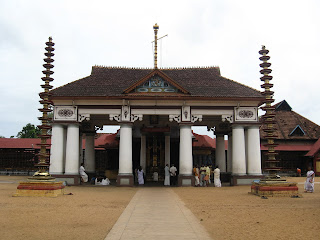 |
| Sree Vaikom Mahadeva Temple, Kerala en.wikipedia.org |
I have overwhelming fascination for the Hindu temples of Kerala not because of their vernacular architecture that is quite congruent with the geomorphology of that region. Nor is it for the richly carved well planned wooden structures and special provision of space for staging art forms - koothambalam in many temples as part of dedication to the presiding deity. What make them stand apart is they are all simplicity personified; there is no embellishment and no display of an array of deities of various shapes and sizes. Yet another interesting fact is their location in a serene ambiance where is there is ample scope for meditating on god. Apart, they follow different worship protocols and admission regulations. No VIP lines as one would find in Andhra or Tamil Nadu.
.jpg) |
| Sree Vaikom Mahadeva Temple, Kerala en.wikipedia.org |
Among the temples dedicated to God Shiva Sree Vaikom Mahadeva Temple on the banks of the Vembanad Lake in Vaikom town of Kottayam district, is an important place of pilgrimage. It is also known as Dakshinakasi (Thekkan Kashi) - Kasi of the south, Kasi temple (in Varanasi) being the holiest in India . The belief has been that devotees who visit this temple, Ettumanoor Shiva Temple and Kaduthuruthy Shiva Temple before the Ucha kaka puja, will be blessed and their wishes fulfilled. They will get salvation - free from the pangs of pain from the birth cycles. The temple is believed to have been built toward the end of the 16th century CE. Vaikom is just 32 km from Ernakulam and 32 km from Kottayam via kumarakom.
 |
| Vaikom backwaters, Kerala. /keralabackwateronline.com |
Believed to be one of the oldest temples of Kerala, the lingam in the Sri Kovil is from Treta Yuga, the third age of Hinduism. Famous for Vaikom Ashtami festival, daily puja and other rituals have never been stopped ever since the consecration of the deity centuries ago which was done by great Parasurama.
Unlike temples of Tamil Nadu or elsewhere where temple worship is based on Vedha Agama, here at the Vaikom temple the Tantric rituals and religious customs are being followed and the priests are from the Nambudiri Brahmin families. Initially, the family members of the Monattu Illam were entrusted with the rights to conduct daily pujas.
rhythmic drum beats for ‘beli’ pooja, at the temple was in a predicament. the reason being there was no male member in the family to conduct puja and the only pregnant woman of the family had to hand over the family held rights to other family to continue the puja rituals. While in a confused state, one night the woman had a sort of apparition of the deity; the divine message was sound and clear: She could herself play the drum at the temple when the beli puja was on and ;there was nothing to be afraid of. The subtle suggestion was it was the edict of God that woman was part of the ritul.
Following day at the temple the Nambudiri woman played on the percussion instrument in an open way without any prior experience when bali puja was in progress. This puja is performed in many temples to please the booth ganas (strange creatures supposedly the attendants of Lord Siva.). That with no training whatsoever or no prior exposure the woman played ‘paanikottu’in a way on par with professionals had surprised the crowd gathered there.
Namboodiri of the Bhadrakali Mattappali mana who was taken aback was quite satisfied and completed the puja along with the tantri. Since this incident the Vaikom Mahadeva temple has had two tantris taking care of the rituals. Kizhakkinedathu Mekkattu Nampoothiri will hoist the flag on the Dwajasthabha on the southern side of the temple and Badrakali Mattappali Nampoothiri on the north side.
https://www.onmanorama.com/travel/kerala/2020/11/19/rituals-customs-vaikom-mahadeva-temple.html









